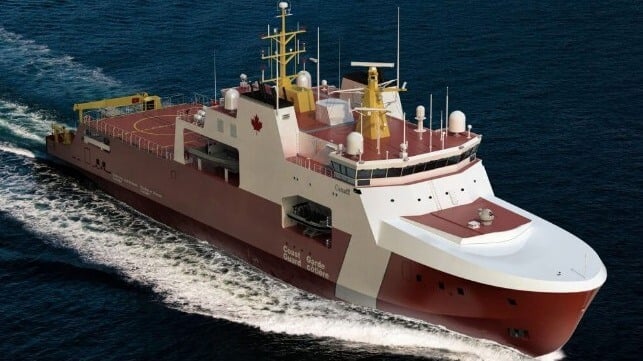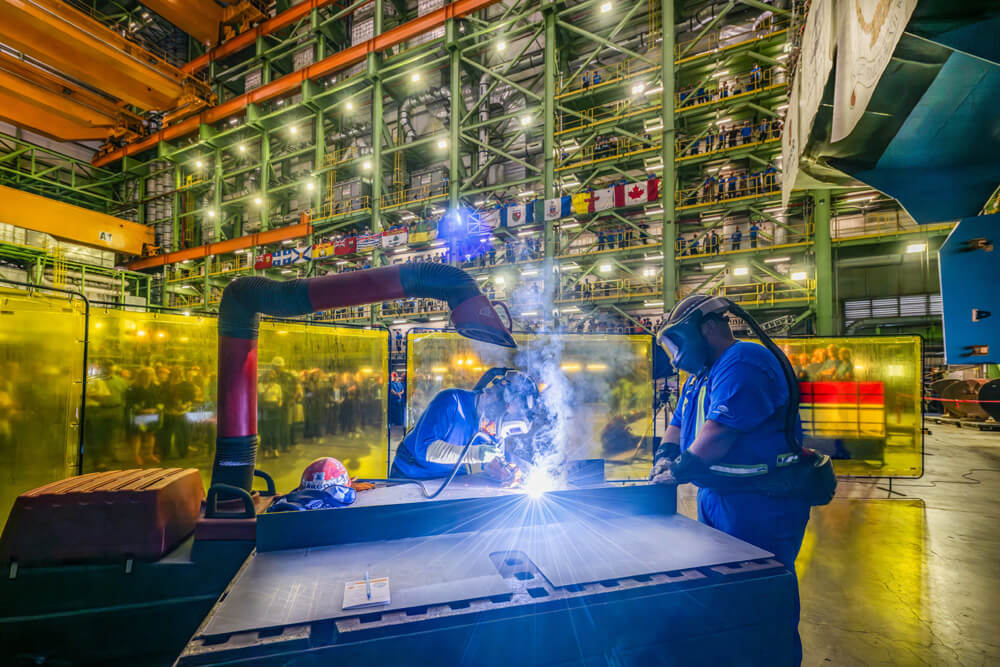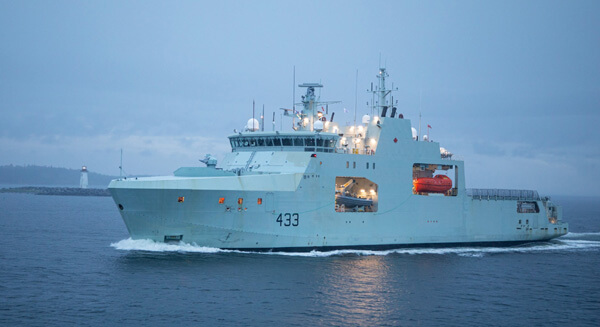Construction Starts on Canadian Coast Guard’s Arctic Patrol Ships

Work is getting underway at Canada’s Irving Shipbuilding in Halifax on the first of two new Arctic and Offshore Patrol Ships (AOPS) for the Canadian Coast Guard’s fleet. By sharing an adapted platform with the Royal Canadian Navy, they are highlighting that the vessels will allow for better cooperation between the two services while also promoting learning and skill-sharing between the crews and expanding the Coast Guard’s capabilities.
The milestone in the project was marked with a ceremonial first steel cut at the shipyard in Nova Scotia. Announced in 2022 as an extension of the contract to build six APOS vessels for use by the Royal Canadian Navy, the first of the two Canadian Coast Guard vessels is expected to be delivered in 2026. Her sistership is due in 2027 and they will replace two of the Coast Guard’s existing five Offshore Patrol Vessels. The new ships are being built under Canadian’s National Shipbuilding Strategy which is also designed to bolster the country’s shipbuilding industry.
Irving has already delivered the first three AOPS to the Royal Canadian Navy with the fourth vessel undertaking sea trials last month and expected to deliver later this summer. The mega blocks for the fifth vessel will be joined this month and the keel laying for the sixth vessel is also scheduled for this month. The fifth vessel is on schedule for delivery in 2024 followed by the sixth to the navy in 2025.
All the ships share the same dimensions with an overall length of approximately 338 feet and 6,677 metric tons displacement. The hull is designed to support icebreaking in the low Arctic during the summer and on the Canadian East Coast during the winter. They are capable of breaking one-meter first-year ice at a speed of 3 knots. The main components of the vessels, such as the hull, engines, and propulsive systems, are consistent across the class.

First steel was cut for the new ship at the shipyard in Halifax, Nova Scotia (Irving Shipbuilding)
“Our Coast Guard members are essential in keeping our waterways clean, safe, and accessible,” said Canada’s Minister of Fisheries, Oceans, and the Canadian Coast Guard, Diane Lebouthillier, during the ceremonies. “Today, as we celebrate the start of the construction of the Arctic and Offshore Patrol Ships, we are proud to invest in the Canadian Coast Guard’s fleet of the future and provide state-of-the-art equipment to our personnel.”
The Canadian Coast Guard's new Arctic and Offshore Patrol Ships will operate as a primary platform to support fisheries enforcement missions on Canada's east coast, including Northwest Atlantic Fisheries Organization patrols. They will also support search and rescue and icebreaking operations on the east coast and will be able to support environmental response and aids to navigation.
While using the same overall design, the last two vessels of the class were modified to comply with the requirements for civilian vessels and meet Canadian Coast Guard’s mission. This includes removing weapons, as well as changes to the bridge layout, the accommodations, mission spaces, the working deck, and tailoring of selected spaces for science missions including the addition of various hull-mounted sensors.

Fourth ship of the class, future HMCS William Hall, on sea trials in July 2023 (Irving Shipbuilding)
The AOPS are highly capable and versatile ships in comparison to the existing offshore patrol vessels. The new ships will be able to operate beyond 120 nautical miles including outside the Exclusive Economic Zone. They will have a top speed of 17 knots and can stay at sea for up to 48 days. They will be able to accommodate a crew of 31 and will have a total of 57 berths.
They will also be outfitted with science equipment and a medical facility to conduct scientific research and support humanitarian assistance missions. A crane and A-frame on the stern will add to the capability to support aid to navigation operations and science research. They will also have a helicopter pad and hangar that will allow the ships to accommodate both the Canadian Coast Guard’s light- and medium-lift helicopters, as well as National Defence's Cyclone helicopters. They will also be capable of loading a shipping container for resupply missions.
During the ceremonies, officials highlighted that the new vessels will be highly versatile. This will allow greater flexibility and adaptability for the Canadian Coast Guard's operations.
